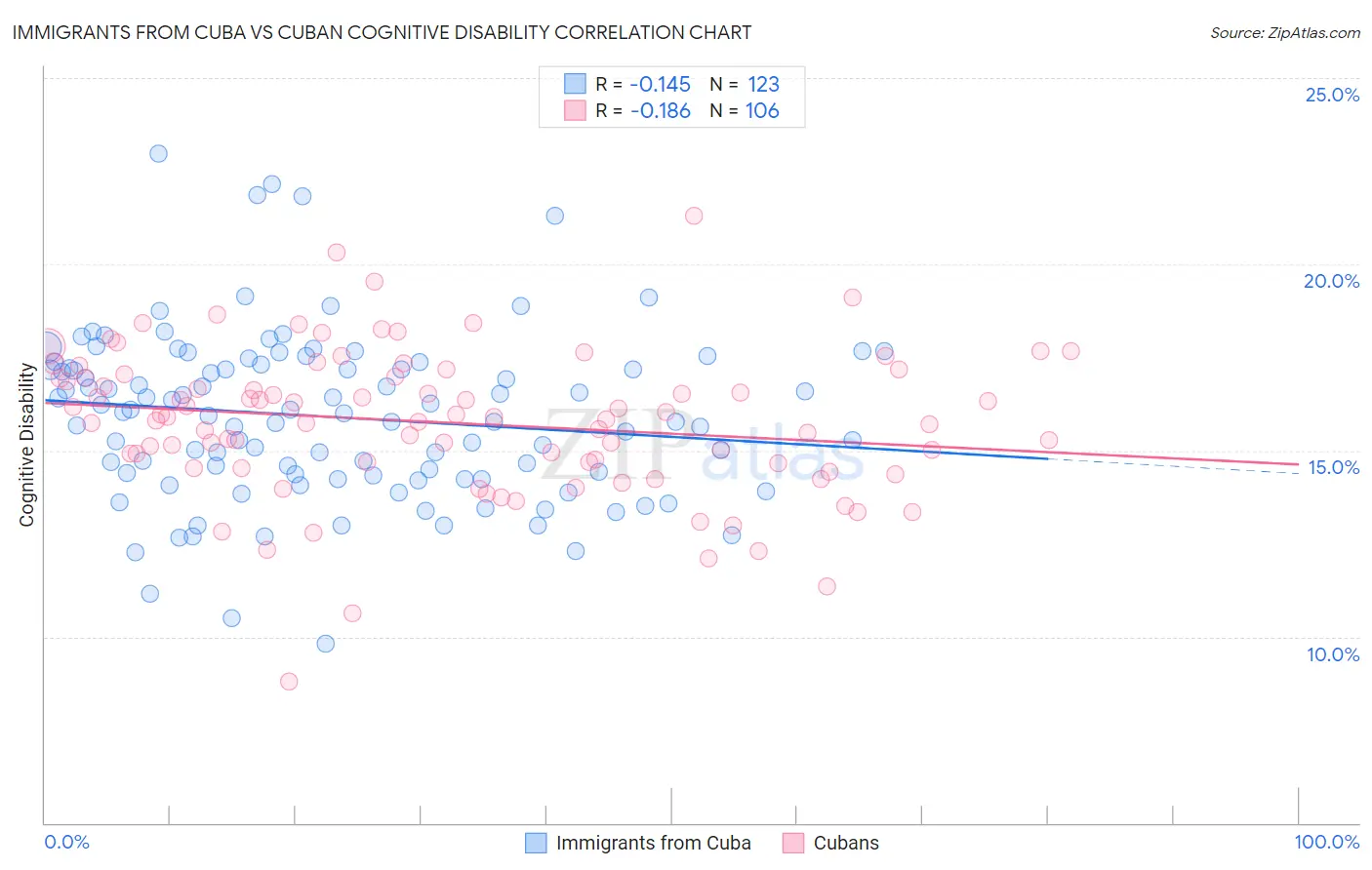Immigrants from Cuba vs Cuban Cognitive Disability
COMPARE
Immigrants from Cuba
Cuban
Cognitive Disability
Cognitive Disability Comparison
Immigrants from Cuba
Cubans
16.3%
COGNITIVE DISABILITY
100.0/ 100
METRIC RATING
21st/ 347
METRIC RANK
16.5%
COGNITIVE DISABILITY
99.9/ 100
METRIC RATING
41st/ 347
METRIC RANK
Immigrants from Cuba vs Cuban Cognitive Disability Correlation Chart
The statistical analysis conducted on geographies consisting of 325,949,473 people shows a poor negative correlation between the proportion of Immigrants from Cuba and percentage of population with cognitive disability in the United States with a correlation coefficient (R) of -0.145 and weighted average of 16.3%. Similarly, the statistical analysis conducted on geographies consisting of 449,269,783 people shows a poor negative correlation between the proportion of Cubans and percentage of population with cognitive disability in the United States with a correlation coefficient (R) of -0.186 and weighted average of 16.5%, a difference of 0.81%.

Cognitive Disability Correlation Summary
| Measurement | Immigrants from Cuba | Cuban |
| Minimum | 9.8% | 8.8% |
| Maximum | 23.0% | 21.3% |
| Range | 13.2% | 12.5% |
| Mean | 15.9% | 15.7% |
| Median | 16.0% | 15.9% |
| Interquartile 25% (IQ1) | 14.3% | 14.7% |
| Interquartile 75% (IQ3) | 17.3% | 17.0% |
| Interquartile Range (IQR) | 3.0% | 2.3% |
| Standard Deviation (Sample) | 2.3% | 2.0% |
| Standard Deviation (Population) | 2.3% | 2.0% |
Demographics Similar to Immigrants from Cuba and Cubans by Cognitive Disability
In terms of cognitive disability, the demographic groups most similar to Immigrants from Cuba are Immigrants from South Central Asia (16.4%, a difference of 0.13%), Croatian (16.4%, a difference of 0.16%), Immigrants from Argentina (16.4%, a difference of 0.19%), Luxembourger (16.4%, a difference of 0.23%), and Immigrants from Croatia (16.4%, a difference of 0.26%). Similarly, the demographic groups most similar to Cubans are Immigrants from Belarus (16.5%, a difference of 0.0%), Bolivian (16.5%, a difference of 0.020%), Immigrants from Eastern Europe (16.5%, a difference of 0.090%), Slovene (16.5%, a difference of 0.11%), and Slovak (16.4%, a difference of 0.26%).
| Demographics | Rating | Rank | Cognitive Disability |
| Immigrants | Cuba | 100.0 /100 | #21 | Exceptional 16.3% |
| Immigrants | South Central Asia | 99.9 /100 | #22 | Exceptional 16.4% |
| Croatians | 99.9 /100 | #23 | Exceptional 16.4% |
| Immigrants | Argentina | 99.9 /100 | #24 | Exceptional 16.4% |
| Luxembourgers | 99.9 /100 | #25 | Exceptional 16.4% |
| Immigrants | Croatia | 99.9 /100 | #26 | Exceptional 16.4% |
| Immigrants | Pakistan | 99.9 /100 | #27 | Exceptional 16.4% |
| Poles | 99.9 /100 | #28 | Exceptional 16.4% |
| Filipinos | 99.9 /100 | #29 | Exceptional 16.4% |
| Czechs | 99.9 /100 | #30 | Exceptional 16.4% |
| Immigrants | Romania | 99.9 /100 | #31 | Exceptional 16.4% |
| Immigrants | Israel | 99.9 /100 | #32 | Exceptional 16.4% |
| Italians | 99.9 /100 | #33 | Exceptional 16.4% |
| Russians | 99.9 /100 | #34 | Exceptional 16.4% |
| Slovaks | 99.9 /100 | #35 | Exceptional 16.4% |
| Greeks | 99.9 /100 | #36 | Exceptional 16.4% |
| Slovenes | 99.9 /100 | #37 | Exceptional 16.5% |
| Immigrants | Eastern Europe | 99.9 /100 | #38 | Exceptional 16.5% |
| Bolivians | 99.9 /100 | #39 | Exceptional 16.5% |
| Immigrants | Belarus | 99.9 /100 | #40 | Exceptional 16.5% |
| Cubans | 99.9 /100 | #41 | Exceptional 16.5% |